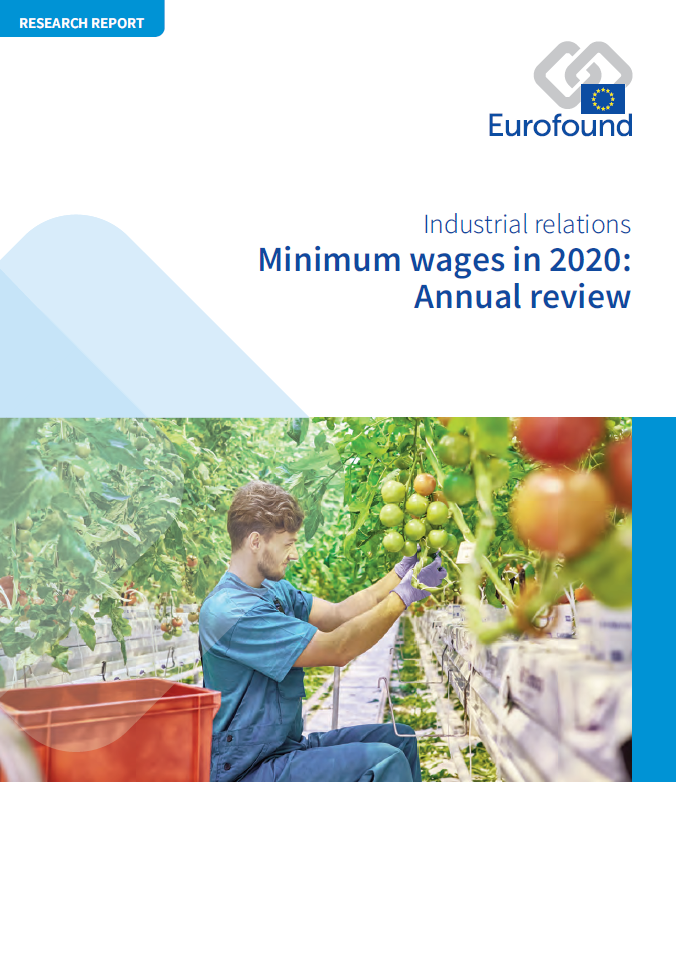
Η παρούσα έκθεση, ως μέρος της ετήσιας σειράς εκθέσεων για τους κατώτατους μισθούς, παρουσιάζει εν συντομία τις βασικές εξελίξεις το 2019 και στις αρχές του 2020 στο πλαίσιο της πρωτοβουλίας της ΕΕ για τους δίκαιους μισθούς, καθώς και τις συζητήσεις σε εθνικό επίπεδο για τον καθορισμό του ύψους τους για το 2020. Η έκθεση διαλαμβάνει σχετικά με τη θέσπιση των κατώτατων μισθών και τον ρόλο των κοινωνικών εταίρων. Πραγματεύεται τις εξελίξεις στο πεδίο των θεσμοθετημένων κατώτατων μισθών και παρουσιάζει στοιχεία σχετικά με το ύψος του κατώτατου μισθού στις συλλογικές συμβάσεις που αφορούν 10 χαμηλά αμειβόμενες θέσεις εργασίας σε χώρες χωρίς θεσμοθετημένους κατώτατους μισθούς. Η έκθεση περιλαμβάνει επίσης μια ενότητα αφιερωμένη στην περιφερειακή διάσταση των κατώτατων μισθών και παρουσιάζει τα πορίσματα των πλέον πρόσφατων ερευνών για τις συνέπειες των αλλαγών των κατώτατων μισθών στους μισθούς, την απασχόληση, τη φτώχεια στην εργασία, τις τιμές και τα κέρδη.
Key findings
Το 2019 πολλές χώρες συζητούσαν την περαιτέρω αύξηση των κατώτατων μισθών μετά το 2020, εν μέρει σε σχέση με κάποιον σχετικό στόχο, εν μέρει σε απόλυτες τιμές.
Οι θεσμοθετημένοι κατώτατοι μισθοί έχουν γίνει δικαιότεροι σε σύγκριση με τους μισθούς άλλων εργαζομένων από τις αρχές της νέας χιλιετίας (όταν η σύγκριση αφορά τους κατώτατους μισθούς με τους μέσους μισθούς όλων των εργαζομένων).
Παρά την ανοδική τάση, στην πλειονότητα των χωρών οι κατώτατοι μισθοί παραμένουν κάτω του 60% ή ακόμη και του 50% των μέσων μισθών. Αυτό ισχύει ιδίως στα κράτη μέλη της κεντρικής και της ανατολικής Ευρώπης, τα οποία στις αρχές της χιλιετίας είχαν ως αφετηρία πολύ χαμηλές σχετικές τιμές, ενώ εξακολουθούν να θέτουν στόχους γύρω ή κάτω από το 50% στους οικείους κανονισμούς για τους κατώτατους μισθούς.
Σε γενικές γραμμές, 7 στους 10 εργαζομένους που λαμβάνουν τον κατώτατο μισθό αναφέρουν ότι αντιμετωπίζουν δυσκολίες για να καλύψουν τις βασικές τους ανάγκες, σε σύγκριση με τους 5 από τους 10 εργαζομένους των λοιπών κατηγοριών. Ωστόσο, οι αριθμοί αυτοί παρουσιάζουν σημαντικές αποκλίσεις από χώρα σε χώρα. Για παράδειγμα, ποσοστό μικρότερο του 10% των εργαζομένων που λαμβάνουν τον κατώτατο μισθό θεωρεί δύσκολη έως πολύ δύσκολη την κάλυψη των βασικών του αναγκών στη Γερμανία, τη Δανία, τη Σουηδία και τη Φινλανδία, ενώ το αντίστοιχο ποσοστό κυμαίνεται μεταξύ του 50% έως 60% στη Βουλγαρία, την Κροατία και την Κύπρο και στο 80% στην Ελλάδα.
Οι κυβερνήσεις σε ολόκληρη την Ευρώπη αντιδρούν με μέτρα σταθεροποίησης του εισοδήματος όσων επηρεάζονται από την κρίση της πανδημίας του COVID-19. Οι κατώτατοι μισθοί μπορούν να διαδραματίσουν κάποιον ρόλο στο μείγμα πολιτικής για τη σταθεροποίηση των εισοδημάτων και, κατά συνέπεια, της ζήτησης ως αντιστάθμισμα στην καθοδική πορεία που οδηγεί σε ύφεση ή σε οικονομική κρίση.
Data
Find data on statutory minimum wages in the EU.
- Data: Proportion of minimum wage workers who find it difficult to make ends meet, EU average
- Data: Minimum wage developments in real terms, 15 euro area countries, 2015 price levels
- Data: Proportion of minimum wage workers who find it difficult to make ends meet
- Data: Statutory minimum wages - Minimum wages in the EU in 2020
List of tables
- Table 1: Social partners’ first reactions to the announced initiative on fair wages
- Table 2: Overview of main arguments and proposals concerning an EU minimum wage initiative from social partners
- Table 3: Gross minimum wages, selected EU Member States and the UK, 2019 and 2020
- Table 4: Sub-minimum rates for selected EU Member States and the UK as at 1 January 2020
- Table 5: Further statutory minimum wage rates for private sector workers in selected EU Member States
- Table 6: Number of collective agreements covering low-paying job categories for countries without statutory minimum wages
- Table 7: Minimum wages in collective agreements, applicable in 2019 for selected low-paid jobs
- Table 8: Collective agreement coverage in Finland
- Table 9: Overview of debates during 2019 on aspects of the minimum wage setting processes
- Table 10: Demands for and agreements on targets for future minimum wages to address adequacy in selected EU Member States and the UK
- Table 11: Regional statutory minimum wage rates
- Table 12: Latest minimum wage research in EU Member States and the UK
- Table 13: Overview of recent empirical research in the EU, Norway and the UK on employment impacts of minimum wage increases, 2019
- Table 14: Policies influencing in-work poverty
- Table A1: Network of Eurofound Correspondents – Members participating in the research
List of figures
- Figure 1: Conceptualising adequate minimum wages
- Figure 2: Estimated share of employees earning 90% to 110% of the minimum wage, EU Member States, 2017
- Figure 3: Proportions of female and male employees, EU level, 2017
- Figure 4: Proportion of minimum wage workers per sector, EU level, 2017
- Figure 5: Proportion of minimum wage workers per occupation (top 10), EU level, 2017
- Figure 6: Hourly minimum wages, selected EU Member States, 2020
- Figure 7: Minimum wage developments in real terms, 15 euro area countries, 2015 price levels
- Figure 8: Minimum wage developments in real terms, non-euro area, 2015 price levels
- Figure 9: Impact of purchasing power on the minimum wage value for selected EU Member States and the UK, as at 1 January 2020
- Figure 10: Relative distance between purchasing power of lowest and median minimum wage EU Member States and the UK and highest minimum wage EU Member States and the UK, 2010–2020
- Figure 11: Process for determining minimum wage rates for 2020
- Figure 12: Number of minimum wage rate updates, EU Member States with statutory minimum wages and the UK, since 2010
- Figure 13: Longer-term trend of development of statutory minimum wages relative to median wages of full-time employed workers, selected countries within the EU and the UK, 2000–2018
- Figure 14: Proportion of minimum wage workers who find it difficult to make ends meet, EU average
- Figure 15: Proportion of minimum wage workers who find it difficult to make ends meet
- Figure 16: Making ends meet and minimum wages in relative and absolute terms
- Figure 17: Monthly minimum wage as a proportion of the mean value of average monthly earnings by NUTS1 region, reference year 2016
- Figure 18: Regional variation of relative monthly minimum wages, by NUTS1 region, 2016
- Figure 19: Examples of countries with higher interregional differences in the proportion of minimum wage workers
- Number of pages
-
86
- Reference nº
-
EF20005
- ISBN
-
978-92-897-2068-7
- Catalogue nº
-
TJ-AS-20-001-EN-N
- DOI
-
10.2806/999852
- Permalink
Cite this publication
